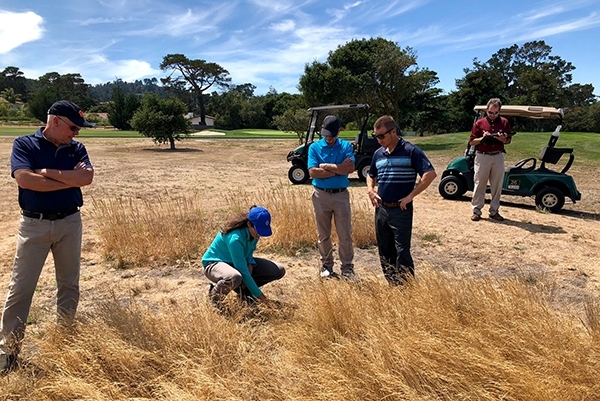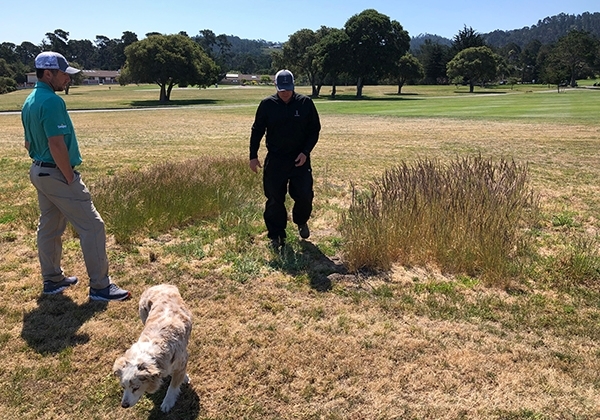Golf courses go wild
When we think about golf courses, we tend to picture miles of well-watered, uniformly clipped, and perfectly manicured grass, not drought-tolerant native grass, wildlife habitat and ecological restoration. However, for Maggie Reiter, a UC Cooperative Extension turfgrass and environmental horticulture advisor based in Fresno County, this is par for the course.
“I've always worked in the turfgrass and golf course management domain,” said Reiter. “Since I began 12 years ago, the proportion of naturalized areas on golf courses has increased. Now native grass stands and wildlife habitat are projected to make up 26% of golf course facilities. From a research and extension perspective, there is little information on management of these natural areas. So, there is a need for expertise on managing golf course naturalized areas for multiple functions, including ecological restoration goals.”
Reiter works with golf course superintendents, who she says are professional stewards of the land. Superintendents seek new methods of maintenance that require less water, fertilizer and labor and promote landscapes that support biological diversity and conservation, in addition to providing a high-quality arena for golf. Golf courses have the potential to provide ecosystem services and community-wide ecological benefits, such as capturing stormwater runoff, providing wildlife habitat, sequestering carbon and relieving urban heat island effects.
One approach Reiter takes to meet these goals is to reduce the amount of maintained turf by converting the less frequently played areas of golf courses to native grasslands. Determining the ideal varieties of grasses to plant can be challenging since there are more than 250 grasses native to California. Native grass seeds are more expensive and less readily available than traditional turfgrasses, which limits the options for use in restoring native grasslands in landscapes. Reiter and her team were able to test only 13 native grasses in their field trials. In addition, the establishment period for native perennial grasses can be two to five years, in contrast to traditional turf varieties that take a few months.
“That is a surprising challenge I didn't anticipate,” Reiter explained. “Golf course superintendents have expectations for naturalized area establishment that do not align with reality because these California native grasses are so different from conventional turfgrasses. I've spent a tremendous amount of time communicating with golf course superintendents, managers, golfers, and other stakeholders to establish realistic expectations.”
Once the experimental grasses are established, Reiter, a golfer herself, has to determine the playability of each variety. Playability of a grass has to do with a player's ability to find the golf ball and advance the ball through the grass and is an important factor in designing naturalized areas. Poor playability on a course can slow down the pace of play, which detracts from the golfer's experience. Measuring stand height, plant density and aboveground biomass indicate visual obstruction, but does this determine playability?
“Measuring playability is an enigma that I think about often, and have no good answer for at this point. There is no consensus in the turfgrass research world on how to measure these complex habitats,” Reiter said. “Engaging in the golf course landscape by playing helps me feel things from the golfer's perspective.”
When Reiter is not on the golf course or working on field trials, she advises schools, parks and recreational sports fields and provides education on general turfgrass management for her local Master Gardener programs as part of her extension work. It turns out that parks and schools are facing major challenges similar to those on golf courses – they need to conserve water and absorb rising labor costs. Reiter says that golf courses may have more resources to respond to these problems, but the tradeoff is that they have higher expectations for aesthetics and performance from native grasses.
Reiter is relatively early in her career, but no doubt she will continue to work with her partners on golf courses and beyond to solve grand problems and incorporate native grasslands within traditional turf areas. It is clear that she is passionate about improving land management practices to protect California's natural resources and promote community health and wellness.
“It is important to me to increase the ecological sustainability of golf courses, and more widely, urban landscapes,” Reiter said.
This article was first published with more photos in The Confluence, the California Institute for Water Resources blog.



